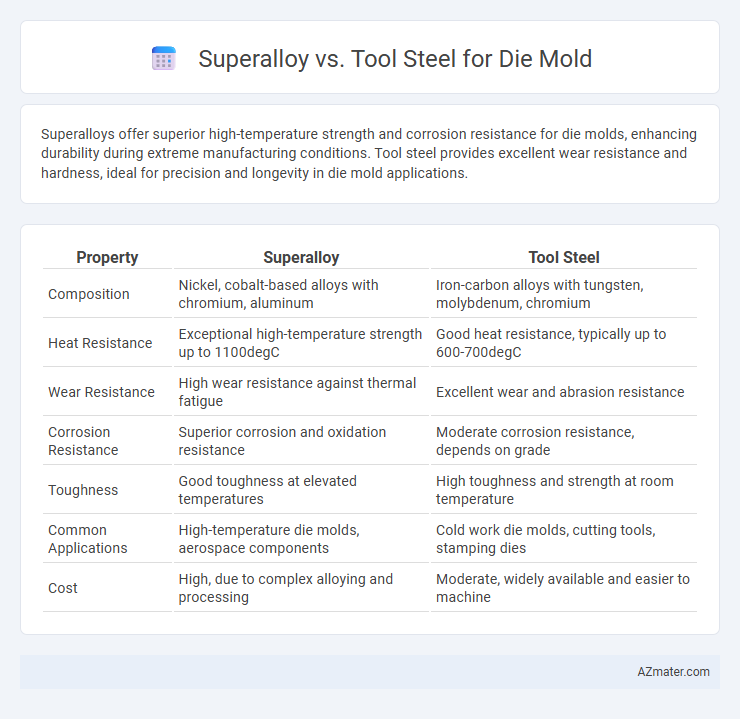Superalloys offer superior high-temperature strength and corrosion resistance for die molds, enhancing durability during extreme manufacturing conditions. Tool steel provides excellent wear resistance and hardness, ideal for precision and longevity in die mold applications.
Table of Comparison
| Property | Superalloy | Tool Steel |
|---|---|---|
| Composition | Nickel, cobalt-based alloys with chromium, aluminum | Iron-carbon alloys with tungsten, molybdenum, chromium |
| Heat Resistance | Exceptional high-temperature strength up to 1100degC | Good heat resistance, typically up to 600-700degC |
| Wear Resistance | High wear resistance against thermal fatigue | Excellent wear and abrasion resistance |
| Corrosion Resistance | Superior corrosion and oxidation resistance | Moderate corrosion resistance, depends on grade |
| Toughness | Good toughness at elevated temperatures | High toughness and strength at room temperature |
| Common Applications | High-temperature die molds, aerospace components | Cold work die molds, cutting tools, stamping dies |
| Cost | High, due to complex alloying and processing | Moderate, widely available and easier to machine |
Introduction to Superalloys and Tool Steels
Superalloys are high-performance alloys primarily based on nickel, cobalt, or iron, engineered for exceptional strength, corrosion resistance, and thermal stability in extreme conditions. Tool steels, composed mainly of carbon and alloying elements like tungsten, molybdenum, and vanadium, are designed for hardness, wear resistance, and toughness essential in die mold applications. Selecting between superalloys and tool steels for die molds depends on factors such as operating temperature, mechanical stresses, and wear resistance requirements, with superalloys excelling in high-temperature environments and tool steels offering superior hardness for cutting and shaping tasks.
Key Properties: Superalloy vs Tool Steel
Superalloys exhibit exceptional high-temperature strength, corrosion resistance, and thermal stability, making them ideal for die molds exposed to extreme conditions. Tool steels offer superior hardness, wear resistance, and toughness, providing excellent durability and precision in molding applications. Selecting between superalloy and tool steel depends on the operating environment, with superalloys favored for heat-intensive processes and tool steels preferred for applications requiring high strength and abrasion resistance.
Thermal Stability and Heat Resistance
Superalloys exhibit superior thermal stability and heat resistance compared to tool steels, maintaining mechanical strength and oxidation resistance at temperatures exceeding 1000degC. Tool steels, while offering good hardness and wear resistance, typically degrade above 600-700degC, limiting their use in high-temperature die mold applications. The enhanced thermal endurance of superalloys makes them ideal for complex die molds exposed to intense thermal cycling and prolonged heat exposure.
Wear and Corrosion Resistance Comparison
Superalloys exhibit superior wear resistance compared to tool steels due to their enhanced high-temperature strength and oxidation resistance, making them ideal for die molds exposed to extreme conditions. Tool steels offer excellent hardness and toughness, providing effective wear resistance under moderate temperatures but often fall short in corrosion resistance when compared to superalloys. Corrosion resistance in superalloys is significantly enhanced by elements like chromium, nickel, and cobalt, whereas tool steels may require additional surface treatments to improve their durability against corrosive environments.
Machinability and Workability Differences
Superalloys exhibit lower machinability compared to tool steels due to their high strength and thermal resistance, requiring specialized cutting tools and slower machining speeds. Tool steels offer superior workability with ease of shaping and finishing, attributed to their balanced hardness and toughness. These differences influence production efficiency and tooling costs in die mold manufacturing, making tool steels preferable for complex machining while superalloys are chosen for high-performance applications.
Performance in High-Pressure Mold Environments
Superalloys exhibit superior high-temperature strength and oxidation resistance compared to tool steels, making them ideal for die molds under extreme high-pressure conditions. Tool steels offer excellent hardness and wear resistance but may experience accelerated thermal fatigue and deformation in prolonged high-pressure mold environments. Selecting superalloys enhances mold longevity and dimensional stability, significantly reducing downtime and maintenance costs in demanding industrial applications.
Cost Analysis: Superalloys vs Tool Steels
Superalloys generally incur higher initial costs due to expensive raw materials and complex manufacturing processes compared to tool steels, which are more affordable and widely available. However, superalloys offer superior high-temperature resistance and longer tool life, potentially reducing total lifecycle costs despite the upfront investment. Tool steels may require more frequent replacement and maintenance, resulting in increased operational expenses over time.
Lifespan and Maintenance in Die Mold Applications
Superalloy die molds exhibit superior lifespan due to their exceptional resistance to high temperatures, oxidation, and wear compared to tool steel, making them ideal for high-volume production. Tool steel requires more frequent maintenance and is prone to faster degradation under extreme thermal cycling and abrasive conditions, increasing downtime and operational costs. Choosing superalloys enhances durability and reduces maintenance intervals, resulting in better long-term performance and cost-efficiency in die mold applications.
Industry Preferences and Case Studies
Superalloys exhibit superior heat resistance and mechanical strength, making them the preferred choice in aerospace and automotive die mold applications where extreme temperatures and stress are prevalent. Tool steels, favored in manufacturing industries for their excellent wear resistance and cost-effectiveness, are commonly used in high-volume production molds requiring sharp cutting edges and precision. Case studies reveal aerospace manufacturers opting for superalloys like Inconel 718 for turbine blade molds, while automotive sectors rely on A2 and D2 tool steels for stamping dies, balancing performance demands and budget considerations.
Choosing the Right Material for Die Molding
Superalloys offer exceptional high-temperature strength and corrosion resistance, making them ideal for die molds in demanding environments where thermal stability is critical. Tool steels provide superior hardness, wear resistance, and toughness, suitable for applications requiring precision and durability under repeated mechanical stress. Selecting the right material for die molding depends on factors such as operating temperature, mold complexity, wear conditions, and cost efficiency, with Superalloys preferred for high-heat, corrosion-prone scenarios and Tool Steels favored for high-wear, impact-intensive usage.

Infographic: Superalloy vs Tool Steel for Die Mold
 azmater.com
azmater.com